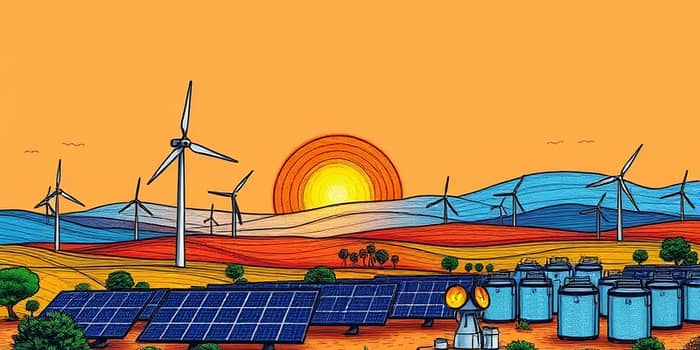Institutional investors are increasingly focusing on renewable infrastructure as a cornerstone for future portfolios. This shift is driven by record-breaking investment trends, supportive policies, and compelling commercial fundamentals. In this article, we explore the forces reshaping global capital flows and provide practical guidance for stakeholders seeking to capitalize on this transformative sector.
Global Investment Trends
Over the past five years, the renewable infrastructure space has witnessed record-breaking global investment trends. Capital inflows into wind and solar projects have surged as investors chase reliable, long-term returns. As energy markets evolve, renewables are claiming an ever-larger share of total energy investment.
Key highlights include:
- Global energy investment is set to hit $3.3 trillion in 2025, with renewables leading the charge.
- Solar energy investment alone is projected at $450 billion in 2025, becoming the single largest line item.
- Wind and solar capital inflows rose by 75% in 2023 compared to the prior year, totaling around $200 billion.
These trends signal that renewables have moved from niche allocations to soaring capital flows into renewables and mainstream portfolio components. For investors, understanding these movements is critical to identifying entry points and structuring resilient investment strategies.
Policy and Regulatory Support
Government frameworks are pivotal in de-risking projects and enhancing returns. In the United States, the enactment of the Inflation Reduction Act (IRA) and the Infrastructure Investment and Jobs Act (IIJA) unleashed historic levels of public-private investment in renewables and hydrogen. These policies have catalyzed over $227 billion in announced projects within two years, with strong tax credits underpinning long-term project viability.
At the state level, more than $24 billion in tax incentives were deployed in 2022, targeting regions with rich renewable resources. Globally, mechanisms like feed-in tariffs and renewable certificate schemes in markets such as China, Vietnam, and parts of Europe have similarly accelerated deployment. This regulatory tailwind provides a blueprint for investors evaluating geographies with robust policy commitments and predictable revenue streams.
To position portfolios effectively:
- Prioritize jurisdictions with stable, transparent incentive structures.
- Monitor policy shifts to anticipate changes in return profiles.
- Engage with local stakeholders to secure off-take agreements early.
Decarbonization and Energy Transition Drivers
Institutional mandates for net zero objectives are intensifying the demand for clean energy projects. Meeting global decarbonization goals will require annual clean energy investment to rise from $1.9 trillion today to $5.3 trillion by 2035. This imperative places renewables at the heart of long-term allocation strategies.
Investors are also scrutinizing grid stability and modernization. As renewable penetration grows, upgrades to transmission networks, energy storage, and digital grid technologies become essential. Balancing intermittent sources with grid reliability calls for urgent net zero decarbonization mandates and strategic infrastructure investments.
Actionable insights for stakeholders include:
- Integrate storage and grid modernization projects into core portfolios.
- Leverage green hydrogen and long-duration storage as emerging opportunities.
- Align with decarbonization roadmaps to access preferential financing.
Commercial and Financial Fundamentals
The investment case for renewables is anchored in robust economics. Between 2013 and 2022, installation costs fell dramatically—solar PV down 69%, onshore wind 33%, and offshore wind 45%. These dramatic drops in installation costs have shifted renewables from subsidized experiments to independent commercial winners.
Moreover, the rapid deployment of clean energy assets is generating significant refinancing and recapitalization opportunities. Existing projects with grid interconnection and repowering potential attract institutional lenders seeking predictable long-term cash flows and stable returns.
Key financial takeaways:
- Explore secondary market acquisitions of operating assets at attractive valuations.
- Structure green loans and bonds backed by stable off-take agreements.
- Consider yieldco vehicles for dividend-oriented investors.
Technological and Industrial Innovation
Innovation continues to expand the renewable infrastructure horizon. Next-generation renewable storage solutions, such as flow batteries and vehicle-to-grid systems, are gaining traction. Meanwhile, the U.S. is witnessing a domestic battery manufacturing boom, positioning it to meet soaring demand through 2035.
Emerging sectors offer fresh institutional entry points:
- Energy storage and long-duration batteries
- Waste-to-energy and bioenergy facilities
- Hybrid energy infrastructure projects co-located with data centers
By partnering with technology providers and securing offtake agreements, investors can capitalize on the next wave of industrial-scale clean energy solutions.
Resiliency Amid Policy and Market Changes
Despite political fluctuations, the commercial drivers for renewables—cost competitiveness, energy security, and stable demand—remain powerful. Periodic market corrections and valuation pullbacks create fertile ground for long-term investors to scale positions at more favorable entry prices.
By treating market disruptions as resilient investment thesis for renewables, institutions can enhance returns and strengthen portfolios against future volatility. Diversifying across regions and technologies also mitigates policy and commodity risks.
Key Statistics and Facts
The following table summarizes the most compelling metrics underpinning the institutional case for renewable infrastructure:
Conclusion
As global capital seeks resilient and sustainable growth avenues, renewable infrastructure stands out for its combination of compelling policy support and innovation. The convergence of technological breakthroughs, stable revenue models, and supportive regulation is transformative power of renewable energy for institutional portfolios.
Investors should continue to deepen expertise in project due diligence, partner with leading technology developers, and engage proactively with policymakers. By embracing renewable infrastructure today, institutions can enjoy robust returns and play a pivotal role in future-proofing large-scale investment portfolios while driving the energy transition forward.
References
- https://www.ifminvestors.com/news-and-insights/thought-leadership/infrastructure-horizons-2025-the-forces-shaping-the-future-of-infrastructure-investing/
- https://am.gs.com/en-us/advisors/insights/article/2025/infrastructure-2025-megatrends-mid-market-opportunities
- https://www.iea.org/news/global-energy-investment-set-to-rise-to-3-3-trillion-in-2025-amid-economic-uncertainty-and-energy-security-concerns
- https://www.cbreim.com/insights/articles/infrastructure-quarterly-q1-2025
- https://www.institutionalinvestor.com/article/sponsored-content/infrastructure-debt-positioned-well-year-ahead
- https://www.cleaninvestmentmonitor.org/reports/us-clean-energy-supply-chains-2025
- https://en.wikipedia.org/wiki/Renewable_energy
- https://www.deloitte.com/us/en/insights/industry/renewable-energy/renewable-energy-industry-outlook.html










